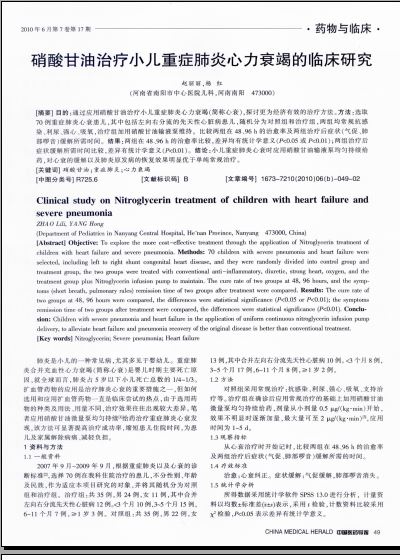硝酸甘油治疗小儿重症肺炎心力衰竭的临床研究
 |
| 第1页 |
参见附件(1134KB,2页)。
[摘要] 目的:通过应用硝酸甘油治疗小儿重症肺炎心力衰竭(简称心衰),探讨更为经济有效的治疗方法。方法:选取70例重症肺炎心衰患儿,其中包括左向右分流的先天性心脏病患儿,随机分为对照组和治疗组,两组均常规抗感染、利尿、强心、吸氧,治疗组加用硝酸甘油输液泵维持。比较两组在48、96 h的治愈率及两组治疗后症状(气促、肺部啰音)缓解所需时间。结果:两组在48、96 h的治愈率比较,差异均有统计学意义(P<0.05或P<0.01);两组治疗后症状缓解所需时间比较,差异有统计学意义(P<0.01)。结论:小儿重症肺炎心衰时应用硝酸甘油输液泵均匀持续给药,对心衰的缓解以及肺炎原发病的恢复效果明显优于单纯常规治疗。
[关键词] 硝酸甘油;重症肺炎;心力衰竭
[中图分类号] R725.6[文献标识码]B [文章编号]1673-7210(2010)06(b)-049-02
Clinical study on Nitroglycerin treatment of children with heart failure and severe pneumonia
ZHAO Lili, YANG Hong
(Department of Pediatrics in Nanyang Central Hospital, He'nan Province, Nanyang 473000, China)
[Abstract] Objective: To explore the more cost-effective treatment through the application of Nitroglycerin treatment of children with heart failure and severe pneumonia. Methods: 70 children with severe pneumonia and heart failure were selected, including left to right shunt congenital heart disease, and they were randomly divided into control group and treatment group, the two groups were treated with conventional anti-inflammatory, diuretic, strong heart, oxygen, and the treatment group plus Nitroglycerin infusion pump to maintain. The cure rate of two groups at 48, 96 hours, and the symptoms (short breath, pulmonary rales) remission time of two groups after treatment were compared. Results: The cure rate of two groups at 48, 96 hours were compared, the differences were statistical significance (P<0.05 or P<0.01); the symptoms remission time of two groups after treatment were compared, the differences were statistical significance (P<0.01). Conclusion: Children with severe pneumonia and heart failure in the application of uniform continuous nitroglycerin infusion pump delivery, to alleviate heart failure and pneumonia recovery of the original disease is better than conventional treatment.
[Key words] Nitroglycerin; Severe pneumonia; Heart failure
肺炎是小儿的一种常见病,尤其多见于婴幼儿。重症肺炎合并充血性心力衰竭(简称心衰)是婴儿时期主要死亡原因,就全球而言,肺炎占5岁以下小儿死亡总数的1/4~1/3。扩血管药物的应用是治疗肺炎心衰的重要措施之一,但如何选用和应用扩血管药物一直是临床尝试的热点,由于选用药物的种类及用法、用量不同,治疗效果往往出现较大差异。笔者应用硝酸甘油微量泵均匀持续[1]给药治疗重症肺炎心衰发现,该方法可显著提高治疗成功率,缩短患儿住院时间,为患儿及家属解除病痛、减轻负担。
1 资料与方法
1.1 一般资料
2007年9月~2009年9月,根据重症肺炎以及心衰的诊断标准[2],选择70例在我科住院治疗的患儿,不分性别、年龄及民族,作为适应本项目研究的对象,并将其随机分为对照组和治疗组。治疗组:共35例,男24例,女11例,其中合并左向右分流先天性心脏病12例。<3个月10例,3~5个月15例,6~11个月7例,≥1岁3例。对照组:共35例,男22例,女13例,其中合并左向右分流先天性心脏病10例。<3个月8例,3~5个月17例,6~11个月8例,≥1岁2例。
1.2 方法
对照组采用常规治疗:抗感染、利尿、强心、吸氧、支持治疗等。治疗组在确诊后应用常规治疗的基础上加用硝酸甘油微量泵均匀持续给药,剂量从小剂量0.5 μg/(kg·min)开始,效果不明显时逐渐加量,最大量可至2 μg/(kg·min)[3],应用时间为1~5 d。
1.3观察指标
从心衰治疗时开始记时,比较两组在48、96 h的治愈率及两组治疗后症状(气促、肺部啰音)缓解所需的时间。
1.4 疗效标准
治愈:心衰纠正。症状缓解:气促缓解,肺部啰音消失。
1.5 统计学分析
所得数据采用统计学软件SPSS 13.0进行分析,计量资料以均数±标准差(x±s)表示,采用t检验,计数资料比较采用χ2检验,P<0 ......
您现在查看是摘要介绍页,详见PDF附件(1134KB,2页)。